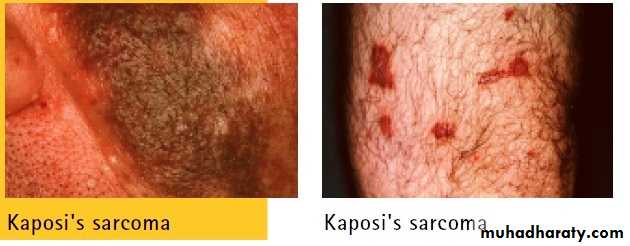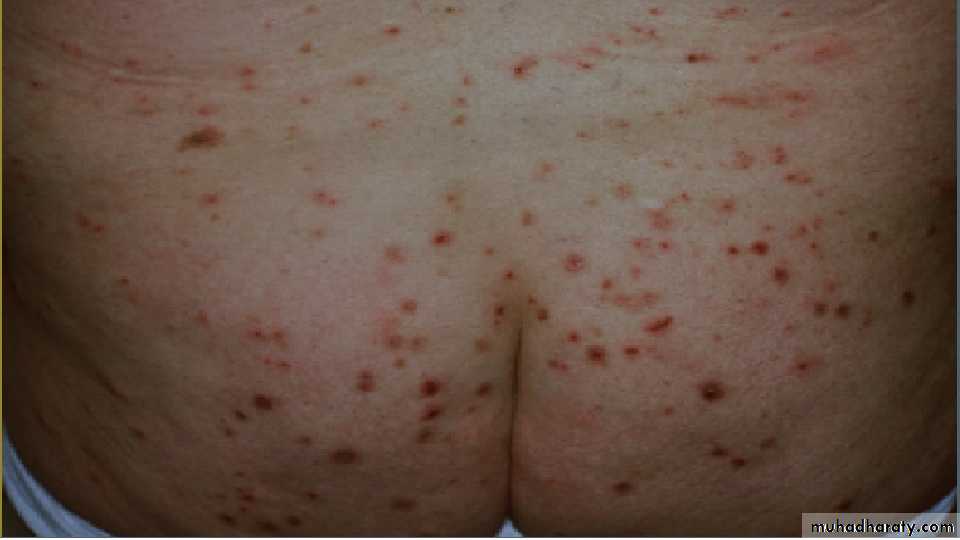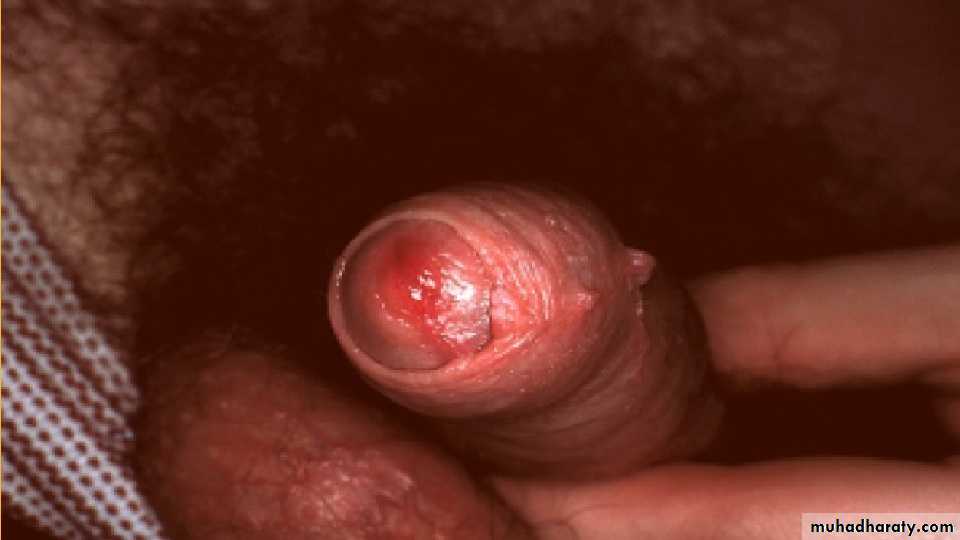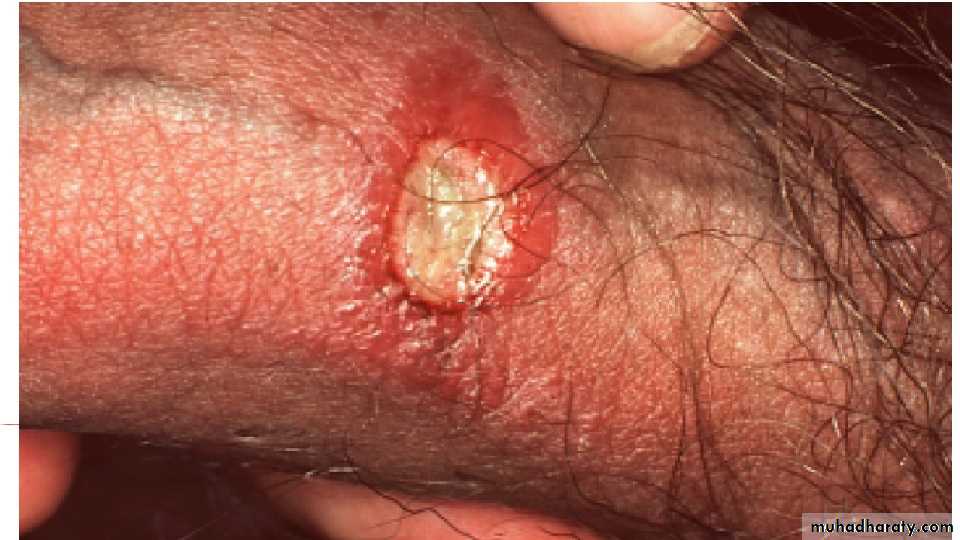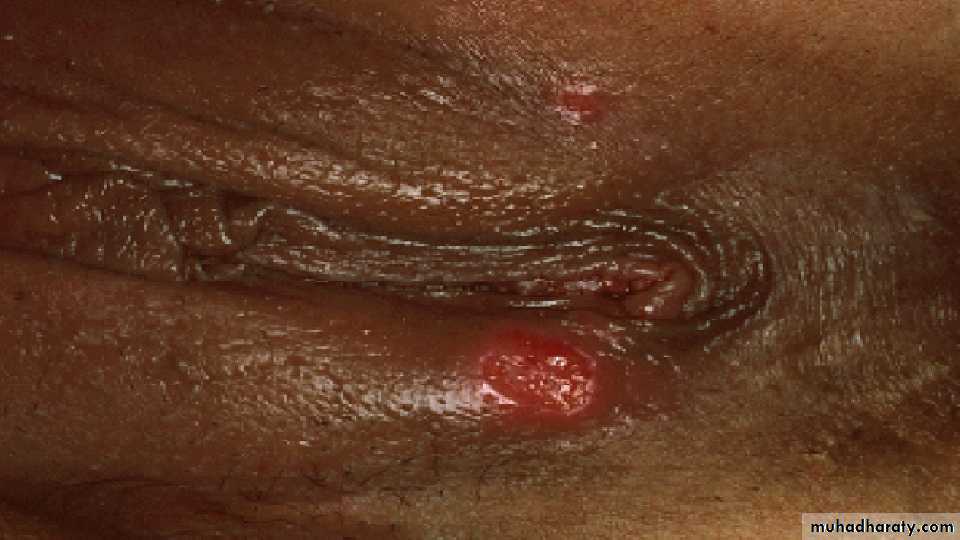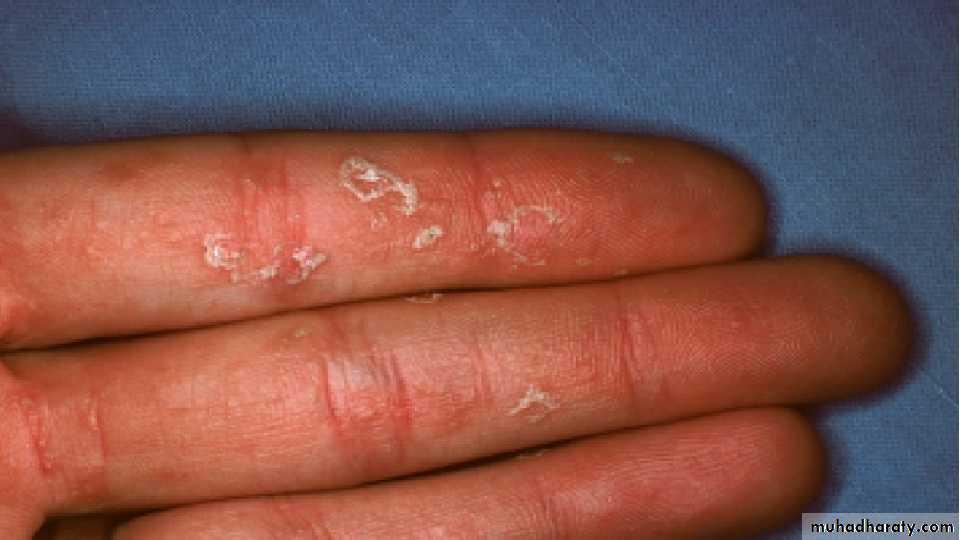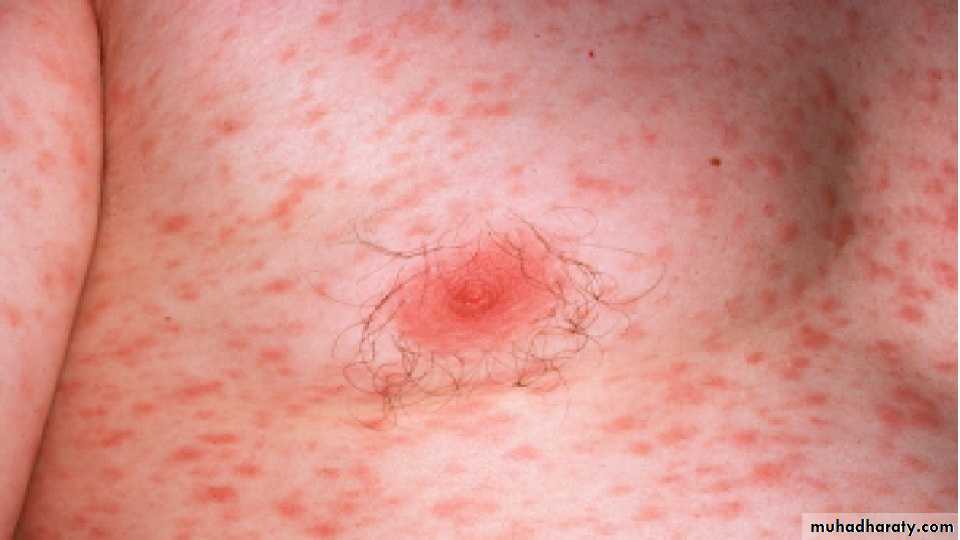Sexually Transmitted Diseases (STDS)
Very important entity of diseases all result from sex problems (abnormal or illegal) and since there is a strong association between venereal diseases and dermatology; we –will study this subject in dermatology, also because patient with venereal diseases may present initially to dermatological clinics.Sexually Transmitted Diseases (STD)
Pathogens:Bacterial:
Neisseria Gonorrhoeae →Gonorrhea
Chlamydia Trachomatis →Trachoma
Mycoplasma Hominis →Post Partum Fever
Ureaplasma Urealiticum→Non-gonococcal urethritis
Mycoplasma Genitalium→ Non-gonococcal urethritis
Treponema Pallidum→Syphilis
Gardnerella Vaginalis→Bacterial Vaginosis
Haemophilius Ducreyi→Chancroid
Shigella→Shigellosis in homosexual
Viruses:
HIV→AIDS
Herpes Simplex→ Genital Herpes Simplex
Human Papillomavirus→Condyloma accuminata, laryngeal papilloma, vulvar papilloma, carcinoma
Hepatitis B,C→acute or chronic hepatitis,
Epstein-Barr virus (EBV)→infectious mononucleosis
Poxvirus→ molluscum contagiosum
Cytomegalovirus (CMV)→retinitis,colitis,encephalitis (HIV)
Human herpesvirus→Kaposi sarcoma
Parasitic:
Entamoeba histolytica→Amebiasis cutisTrichomonas vaginalis→Trichomoniasis
Pthirius pubis→pediculosis pubis
Sarcoptes scabiei→scabies
Fungi: Candida albicans→candidiasis
Clinical manifestations
→localized→systemic
Localized manifestations:
Pruritus: Causes of itching: scabies, pediculosis pubis, trichomoniasis, candida albicans,Ulcer on genitalia: syphilis, chancroid, herpes, lymphogranoloma venerum,
Mass on genitalia: venereal wart (condylomata acuminate), syphilitic condylomata lata, molluscum contagiosum
Discharge: urethral (Gonorrhea, non-specific urethritis, Escherichia coli, candidiasis)
Systemic manifestations:
Secondary rash of syphilisJaundice (hepatitis virus): generalized itching
AIDS
Disseminated gonorrhea
Gonorrhea
Gonorrhea
It is bacterial infection caused by Neisseria gonorrhoeae a gram- negative, infects columnar or cuboidal epithelium.Site of infection: the organism can survive only in blood and on mucosal surfaces including the urethra, endocervix, rectum, pharynx, conjunctiva, and prepubertal vaginal tract. It does not survive on the stratified epithelium of the skin and postpubertal vaginal tract. It can disseminated locally and systemically.
Mode of infection: almost always by sexual intercourse.
Diagnosis:
• Gram's stain: the presence of intracellular diplococci within polymorphonuclear leukocytes→presumptive diagnosis• culture →gold slandered for diagnosis
• Nucleic acid amplification tests: have high sensitivity, and they also test for C.trachomatis.
• serologic test: non-available; all patients should have a serologic test for syphilis and HIV.
Genital Infection In Males
Urethritis: after a 3-5 days incubation period, most infected men have a sudden onset of burning, frequent urination, and a yellow thick, purulent urethral discharge.Some of patients have long period of incubation and they then complain only of mild dysuria with a mucoid urethral discharge as observed in nongonococcal urethritis or become chronic carriers, acting as women without symptoms.
Complications: epididymitis, seminal vesiculitis, and prostatitis.
Genital Infection In Females
The majority of female with gonorrhea are asymptomatic.While the urethra and rectum are often involved, the locus of infection is endocervix.Cervicitis: may appear normal or with nonspecific pale yellow vaginal discharge or it may show marked inflammatory changes with erosions and pus exuding from the ostium Skene's glands, which lie on either side of the urinary meatus.
Urethritis: begins with variable intensity of frequency and dysuria.
Bartholin Ducts: the Bartholin ducts, which open on the inner surfaces of the labia minora near the vaginal opening, if infected, show a drop of pus at the gland orifice.
After occlusion of the infected duct, the patient complains of swelling and discomfort while walking or sitting.
Pelvic Inflammatory Disease (PID)
PID or salpingitis, is infection of the uterus, fallopian tubes, and adjacent pelvic structures. Organism spread to these from the cervix and vagina. most cases caused by C. trachomatis and\or N. gonorrhoeaeOther causes: microorganism of the normal vaginal flora, micoplasma hominis and ureaplasma urealyticum.
Risk factors: age (under 20) years, previous PID, vaginal douching, and bacterial vaginosis.
Clinical presentation: symptoms range from minimal lower abdominal pain usually bilateral to severe pain accompanied by peritoneal signs. PID is an important cause of infertility.
Extragenital Gonorrhea
Rectal Gonorrhea: is acquired by anal intercourse or by contamination from genital gonorrhea. Gonococcal Pharyngitis: gonococcal pharingitis is acquired by oral exposure and rarely by kissing. Most cases are asymptomatic.Disseminated Gnonococcal Infection (Arthiritis-Dermatitis Syndrome): DGI is the most common cause of acute septic arthritis in adult. The classic triad is dermatitis, tenosynovitis, and migratory polyarthritis.
Treatment
the standard therapy recommended in uncomplicated infections of the urethra, cervix, rectum, or pharynx in nonpregnant adults is a single dose of 250mg of ceftriaxone plus doxycycline 100mg twice daily for 7 days (for Chlamydia).Alternative:
Spectinomycin 2g IM in one dose
Ciprofloxacin 500mg orally in one dose
Norfloxacin 800mg orally in one dose
Ceftizoxime 500mg IM in one dose
Cefotaxime 1g in one dose
To all these doxycycline 100 mg twice daily for 7 days.
Nongonococcal Urethritis (NGU)
The diagnosis, as the name implies, used to be one of exclusion.
Organisms:
Genital chlamydial is responsible for about half of NGU
Ureaplasma urealyticum and mycoplasma genitalium cause 10-30% of NGU
Herpes viruses, T. vaginalis, haemophilus species, and anaerobic bacteria account less than 10% of cases
One third of cases, no infectious cause can be found.
Nongonococcal Urethritis in males. NGU begins 7-28 days after sexual contact with a smarting sensation while urinating and a mucoid discharge.
•
• NGU• Gonococcal urethritis
• Incubation period
• 7-28 days
• 3-5 days
• Onset
• gradual
• Abrupt
• dysuria
• Smarting feeling
• Burning
• discharge
• Mucoid or purulent
• Purulent
• Gram stain
• Polymorphonuclear leukocytes
• Gram-negative intracellular diplococci
Nongonococcal Urethritis in females. The sign and symptoms in females are more nonspecific; may be present mucopurulent discharge. Treatment: azithromycin 1gm orally in a single dose or doxycycline 100mg orally twice a day for 7 days. Alternative: erythromycin 500mg orally four times a day for 7 days.
Reiter Syndrome (Reactive Arthritis with Conjunctivitis\Urethritis\Diarrhea): the syndrome is a characteristic clinical triad of urethritis, conjunctivitis, and arthritis. The skin involvement commonly begins with small guttate, hyperkeratotic, crusted, or pustular of the genitals, palms, or soles.
Syphilis
SyphilisSyphilis also known as lues, is a contagious, sexually-transmitted disease caused by the spirochete Treponema Pallidum.
The spirochete enters through the skin or mucous membranes, on which the primary manifestations are seen. In congenital syphilis the treponema crosses the placenta and infects the fetus.
Routes of infection:
1) sexual contact (most important)
2) congenital
3)acquired by transfusion of blood
4)accidental
Stages (untreated syphilis)
• Primary S: localized infection at site of inoculation (chancre)• Secondary S: disseminated infection
• Latent S: no clinical sign or symptoms (seropositive)
• Early latent S: less than one year duration
• Late latent S: greater than one year duration
• Syphilis of unknown duration
• Late (tertiary) S: cutaneous, vascular, neurologic findings
• Congenital S: acquired in utero
Risk of transmission: during primary, secondary, and early latent stages of disease. The patient is most infectious during the first and second year of infection.
Primary Syphilis
Chancre (primary stage); after an incubation period of 10-90 days chancre develop; it is a acquired by direct contact with an infectious lesion of the skin or the moist surface of the mouth, anus, or vagina. Chancres are usually solitary, but multiple lesions are not uncommon.PRIMARY Syphilis (CHANCRE)
The lesions begins as a papule that undergo ischemic necrosis and erodes, forming a 0.3-2.0cm, painless, hard, indurated ulcer; the base is clean, with serous discharge. On palpation between two fingers, a cartilage-hard consistency is sensed. The regional lymph nodes on one or both sides are enlarged.
Diagnosis: clinical suspicion, conformed by dark filed examination.
DD: any genital lesion, primary syphilis should be considered until ruled out clinically and by specific test.
Chancre & Chancroid
•• chancre
• chancroid
• Cause
• Spirochete in the serum
• Ducrey bacillus in the smear
• incubation
• 3 weeks
• 4-7 days
• Pain
• painless
• Painful
• inflammation
• Has no surrounding inflammatory zone
• large surrounding inflammatory zone
• Edge
• It is not undermined
• It is undermined
• Lesions
• Usually single
• Multiple
• palpation
• Cartilage hard
• Soft to the touch
• The surface
• Has dark, velvety red without membrane
• Yellowish red with membrane
• adenopathy
• Bilateral usually
• Usually unilateral
Course: if left untreated heal spontaneously with scarring in 3-6 weeks and secondary syphilis appear
Secondary syphilis
Cutaneous lesions: also called syphilids, appears 2-6 months after primary infection and 2-10 weeks after primary chancre.Lesions: the lesions of secondary S have certain characteristics that differentiate them from other cutaneous diseases:
There is little or no fever at the onset
Lesions are noninflammatory, develop slowly, and may persist for weeks or months
Pain or itching is minimal or absent
There is a marked tendency to polymorphism
Color resembling a "clean-cut ham" or having a coppery tint
Lesions have variety of shapes
Types of lesions:
Macular eruption. The most common. The appearance of an exanthematic erythema extends rapidly; appears on the sides of the trunk, about the navel, and on the inner surfaces of the extremities.Papular eruption. The most common and also most easily recognized. Papules are distributed on the face, flexures of the arms and lower legs, over the trunk, and classically there are lesions on the palms and soles.
Split papules are hypertrophic , fissured papules that form in the creases of alae nasi and at the oral commissures.
Papulosquamous syphilids. sometimes have features of psoriasiform eruption.
Follicular or lichenoid syphilids.
Annular syphilids like sarcoidosis
Condylomata lata is a papular, relatively broad and flat, located on folds of moist skin, especially about the genitalia and anus; they may become hypertrophic and, instead of infiltrating deeply, protrude above the surface, forming a soft, red, often mushroom-like mass. They are not covered by the digitate elevations characteristic of venereal warts (condylomata acuminate). This later is true verruca, caused by human papillomavirus.
Syphilitic alopecia is irregularly distributed so that the scalp has a moth-eaten appearance.
Mucous membrane. The most common mucosal lesion is syphilitic sore throat, diffuse pharyngitis that may be associated with tonsillitis or laryngitis. Mucous patches which are macerated, teem with treponema, on the tonsils, tongue, gums, lips, or in the genitalia.
Systemic involvement generalized lymphadenopathy
Note. All cutaneous lesions of secondary syphilis are infectious; therefore, if you do not know what is, do not touch. Cellular immune processes are responsible for the cutaneous manifestations of secondary syphilis.Diagnosis. Clinical suspicion confirmed by dark-filed examination and\or serology (STS).
DD. syphilis has long been known as the 'great imitator' because the various cutaneous manifestation may simulate almost any cutaneous or systemic disease.
Latent Syphilis
During this latent period there are no clinical signs of syphilis, but the serologic tests are reactive. During the early latent period infectivity persists: for at least 2 years a women with early latent S may infect her unborn child.Tertiary Cutaneous Syphilis
Tertiary S most often occur 3-5 years after infection. 16% of untreated patients will develop tertiary lesions of the skin, mucous membranes, bone, or joints and heal with scarring. Treponema are usually not found by darkfiled examination. Systemic disease also develop including cardiovascular disease, CNS lesions.Two main types: noduloulcerative syphilid and the gumma.
Gumma (latin: Gum), the term describes the rubbery lump or deep granulomatous lesion, found in the subcutaneous tissue, having a tendency for necrosis and ulceration.
Diagnosis: clinical finding, confirmed by STS and biopsy; darkfiled examination is always negative.
DD: TB, malignancy, lymphoma.
Congenital Syphilis
Prenatal S is acquired in utero from the mother, who usually has early syphilis. Transmission of the T. pallidum across the placenta may occur at any age of pregnancy, but the lesions generally develop after the fourth month of gestation, when fetal immunologic competence begins to develop; so treatment of the mother prior to this time will almost always prevent infection in the fetus.In untreated cases, may appear: (1) stillbirth (2) infants die shortly after birth (3) without symptoms at birth, but will have late symptomatic congenital syphilis a few weeks after birth or at puberty; for this reason prenatal syphilis is divided into early and late congenital syphilis.
Early Congenital Syphilis
Early Congenital Syphilis is defined as syphilis acquired in utero that becomes symptomatic during the first 2 years of life.-Neonates is usually premature, marasmic, fretful, and dehydrated. The face is pinched and drawn, resembling that an old man or women. Multisystem disease is characteristic.
-Snuffles, a form of rhinitis, is the most frequent and often the first specific finding. In persistent and progressive cases ulceration develop that may involve the bones and cause perforation of the septum or development of saddle nose, which are important stigmata later in the disease. (the destructive effects of syphilis often leave scars or development defects called stigmata)
-Cutaneous lesions of congenital S resemble those of acquired secondary S. with exaggeration.
Late Congenital Syphilis
Symptoms and signs of late congenital S become more evident after age 5 years. The most important signs are:Frontal bosses (bony prominences of the forhead).
Saddle nose
Short maxilla
High arched palate
Mulberry molars (more than four small cusps on a narrow first lower molar of the second dentition).
Hutchinson's teeth (peg-shaped upper central incisors of the permanent dentition that appear after age 6 years)
Higouménaki's sign (unilateral enlargement of the sternoclavicular portion of the clavicle as end result of periostitis)
Rhagades (linear scars radiating from the angle of the eyes, nose, mouth, and anus)
Hutchinson's triad (Hutchinson's teeth, interstitial keratitis, and cranial nerve V111 deafness) is considered pathognomonic of late congenital syphilis.
Serologic Tests for Syphilis
There are two types of STS
• 1) Nontreponemal test or classic reaction: detects antibodies against phospholipids antigens
• 2) Treponemal test or specific test: detects antibodies direct against T.Pallidum.
-the use of one type is not sufficient for diagnosis
- Nontreponemal test correlate with disease activity (reported quantitatively); they are rapid plasma reagin(RPR) and venereal disease research laboratory (VDRL)
-Treponemal test correlate poorly with disease activity and remains positive lifetime, regardless of treatment; they are:
Microhemagglutination assay for T.pallidum (MHA-TP)
Fluorescent treponemal antibody absorption(FTA-ABS)
T-pallidum particle agglutination (TP-PA)
Biologic False-Positive Tests Results (BFP)
The term BFP is used to denote a positive STS in persons with no history or clinical evidence of syphilis; two types:-Acute BFP reactions are defined as those that revert to negative in less than 6 months, may result in; vaccinations, pregnancy, infections (hepatitis, measles, typhoid, varicella, influenza, malaria)
-Chronic BFP reactions positive test persist for more than than 6 months, seen in: connective tissue diseases, chronic liver disease, multiple blood transfusion, and advancing age.
Treatment
TreatmentPenicillin remains the drug of choice for treatment of all stages of syphilis.
• 1) Patients with primary, secondary, or early latent syphilis of less than 1 year duration:
-recommended treatment: Benzathine penicillin G. 2.4 million units IM in one dose.
-alternative treatment in nonpregnant, penicillin allergic:
Tetracycline 500mg orally four times a day for 2 weeks
Doxycycline 100mg orally twice a day for 2 weeks.
Ceftriaxone 1g IM or IV for 8-10 days
Azithromycin 2g as a single oral dose
2)Patients with late latent syphilis of more than one year duration
-recommended treatment: Benzathine penicillin G. 2.4 MU IM once a week for 3 weeks-alternative treatment in nonpregnant, penicillin allergic:
Tetracycline 500mg orally four times a day for 30 days
Doxycycline 100mg orally twice a day for 30 days
3) Pregnant women with syphilis should be treated with penicillin in doses appropriate for the stage of syphilis. Pregnant women who allergic to penicillin should be skin tested and desensitized if test results are positive.
Chancroid (Soft Chancre)
It is an infectious, ulcerative, STD caused by the Gram-negative bacillus Haemophilus ducreyi ( the Ducrey bacillus).One or more deep or superficial tender ulcer on the genitalia, and painful adenitis in 50% which may suppurate, are characteristic of the disease. Men outnumber women many fold.
After an incubation period of 3-5 days, a painful, red papule appears at the site of contact and rapidly becomes pustular and ruptures to form an irregular-shaped ulcer with a red halo. The ulcer is deep, bleeds easily, and spread laterally, burrowing under the skin and giving the lesion an undermined edge. The ulcers are highly infectious, and multiple lesions appear on the genitals from autoinoculation, heal with scarring.
Unilateral or bilateral inguinal lymphadenopathy develops , after 1 week of the onset of disease, and may rupture spontaneously.
Diagnosis: the combination of a painful ulcer with tender inguinal adenopathy is suggestive, and when accompanied by suppurative inguinal adenopathy , is almost pathognomonic.
Probable diagnosis is made when all the following criteria are met:
One or more painful genital ulcers are present
There is no evidence of T.pallidum infection
The clinical features of chancroid
A test result for herpes simplex is negative
DD: most frequent mistaken is herpes progenitalis which have recurrent grouped vesicles at the same time
Treatment:
-recommended: one dose of either azithromycin 1gm orally or ceftriaxone 250mg IM.-alternative: ciprofloxacin 500mg orally twice daily for 3 days
Erythromycin 500mg four times daily for 7 days
Granuloma Inguinale (Donovanosis)
Granuloma inguinale is a mildly contagious, chronic, granulomatous, locally destructive disease characterized by progressive, indolent, serpiginous ulcerations of the groins, pubes, genitalia, and anus.-The disease begins as single or multiple subcutaneous nodules, which erode through the skin to produce clean, sharply defined lesions, which are usually painless.
-Inguinal swellings are not lymphadenitis but represent subcutaneous perilymphatic granulomatous lesions that may eventually break through the skin, causing sinus formation. Complications include elephantiasis, stricture, and pelvic abscess.
Site: genitalia (90%), inguinal (10%), anal (1-5%).
The incubation time is unknown, 2-3 weeks most common.
Etiology: Granuloma inguinale is caused by the Gram-negative bacterium klebsiella granulomatis. The exact mode of transmission of infection is undetermined. Venereal but also nonvenereal transmition occurs.
Diagnosis is confirmed by finding the organism (Donovan bodies) in the lesions, will be found within mononuclear cells.
DD: granuloma inguinale may be confused with ulceration of the groin caused by syphilis or carcinoma, but it is differentiated from these disease by its long duration and slow course, by the absence of lymphatic involvement, and, in the case of syphilis, by a negative test and failure to respond to antisyphilitic treatment.
Recommended Treatment:
Trimethoprim-sulfamethoxazole, one tablet orally twice a dayDoxycycline, 100mg orally twice a day
Alternative Treatment:
Ciprofloxacin, 750mg orally twice a day
Erythromycin 500mg four times a day
Azithromycin, 1g orally once a week
-All for 3 weeks

